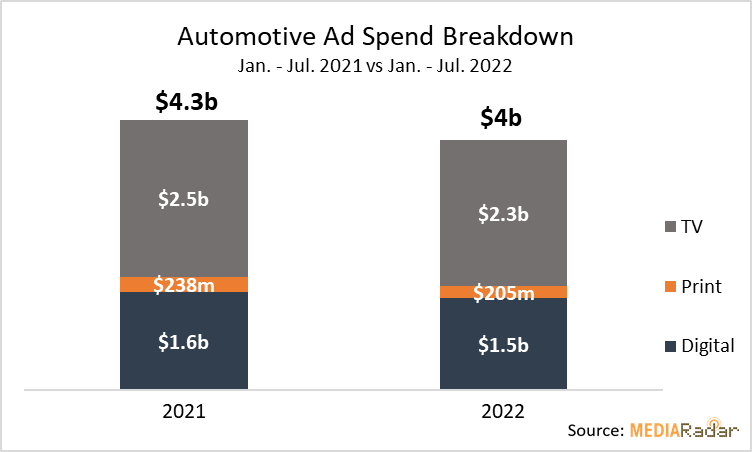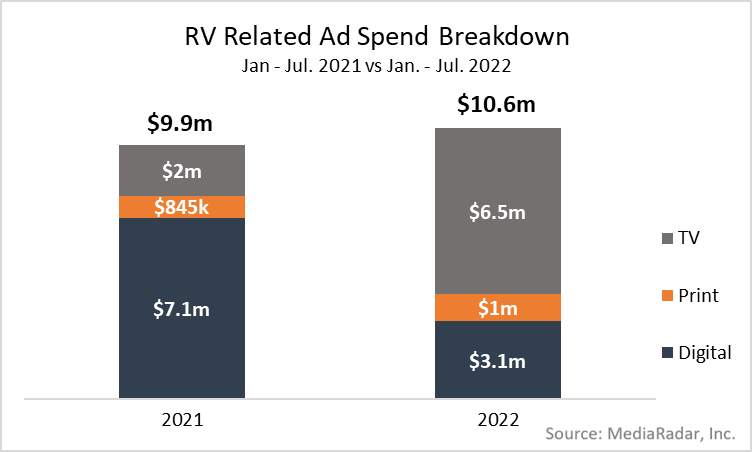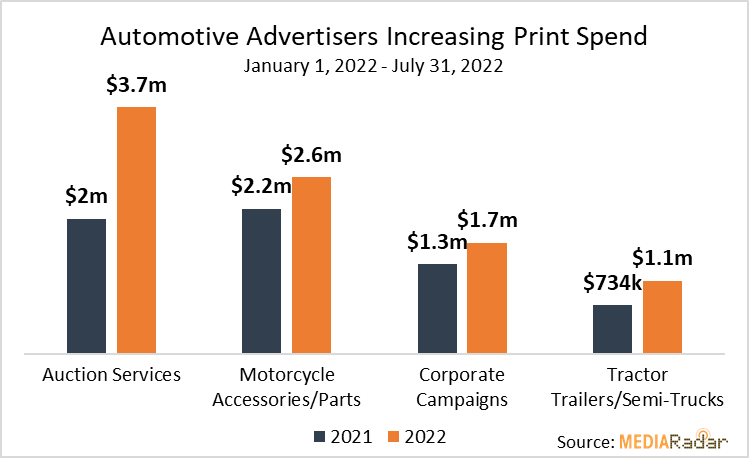
The global automotive market is projected to reach nearly $95t (yes, that’s a “t”) this year, making it one of the biggest industries in the world.
A big industry calls for advertisers with even bigger budgets, right?
Not so fast. (Get it?)
The pandemic, coupled with an uncertain economy, has pushed car buying and related purchases to the back of many peoples’ minds.
Sales of new vehicles in the US fell by about 15% in 2020, one of the biggest declines in decades.
While car sales have recovered a bit since then, the recession and rising prices have prevented advertisers from returning to pre-pandemic spending levels.
Through July 2022, automotive-related advertisers decreased spending by more than 8% YoY ($4.3b vs. $4b).

That said, some automotive advertisers did spend—and those that did, spent big.
Despite the overall industry spending less through July, six categories spent more, including Model/Brands (up by 2%), Automotive Aftermarket Parts & Accessories (up by 8%), Automotive Websites (up by 94%), Automotive Maintenance & Repair Products (up by 4%), Motorcycles (up by 40%) and Automotive Additives & Fluids (up by 23%).
These advertisers spent a combined $3.3b through July, driven by domestics, imports and SUVs. Advertisers for electric cars, including Chevy (Bolt EV), Kia (Kia EV6) and Volkswagen (Volkswagen ID.4), increased their investment as well.
Clearly, automotive advertisers are all over the road.
So, what’s the deal?
We looked at our data to find out.
Tough Times for Dealerships (and Their Advertisers)
Few industries have gone unencumbered longer than the automotive industry.
Since the first Model T rolled out of Ford’s Piquette Avenue plant in 1908, the car-buying process has gone relatively unchanged.
If you wanted a car, you went to a dealership.
As technology crept into the industry and the Internet began to influence purchase decisions, some of this process went online. But for all intents and purposes, buying a car still required you to walk through showroom doors.
That’s changing fast as consumers realize how easy it is to buy a car online.
This shift, which likely wouldn’t have happened for years if not for the pandemic, has forced advertisers working for dealerships to take their foot off the gas.
Through July, both Used Car Dealerships and Auto Dealerships significantly decreased ad spending.

New Dealerships scaled back their ad spend by 42% YoY due mainly to a 98% YoY decrease in TV spending.
To make up for their dwindling TV presence, these advertisers increased spending on digital and print by 29% and nearly 1000%, respectively.
Used Car Dealerships did the opposite, decreasing print and digital spending by 94% and 73%, respectively. These advertisers offset those decreases by increasing TV spending by more than 1,000%.
Although these advertisers have traveled down different roads so far in 2022, the challenge in front of them is the same: The traditional dealership model is dead.
In the short term, an increase in ad spending may follow, especially as the cost of cars normalizes. But the fact that Ford’s CEO recently expressed his desire to move away from dealerships doesn’t bode well for their future.
As a result, ad spending from these advertisers will likely continue to decrease in the long term as dealerships get locked out of the industry.
Hitting the Open Road
After more than two years of travel restrictions, people are hopping in their cars and boarding planes to make up for the lost time.
They’re jumping into RVs, too.
In 2021, the RV industry produced 600,000 RVs, surpassing the record by 19%.
These advertisers are taking advantage of the road-tripping surge, increasing their spending by 7% YoY through July.

Most of this spending came from RV dealerships, including Camping World, which accounted for 83% of the $10.6mm invested.
While that’s not surprising—despite sky-high gas prices putting a damper on their strategies—their media mixes were a bit…odd.
Instead of investing more in digital like other advertisers, RV advertisers decreased digital spending by 57% YoY. Then, they moved that money to print and TV, which increased by 22% and 230% YoY, respectively.
Why?
The likely reason: the demographic of RV buyers.
While this lifestyle is becoming popular with younger generations, most people buying RVs today are older.
In fact, 66% of RV owners are ages 55+, while 42% are retired and 74% live with no children in the home.
RV advertisers are banking on the fact that people who fall into these buckets are generally less tech-focused and more likely to still consume content via TVs, newspapers and magazines.
At the same time, the fact that people are less likely to buy RVs online probably has a lot to do with the increase in traditional ad spending.
Still, to ignore the role of digital in the RV purchase would be a mistake, especially as younger generations and influencers shun the corporate world for a nomadic lifestyle.
So, while the traditional car dealership is under fire, RV dealerships may be fine for the time being.
That said, it wasn’t long ago that buying a car online seemed outlandish.
Are RVs next?
Modern Cars, Old-School Ads
In 1952, Delta Democrat-Times published an article titled “Cheer Up! World Will Be Wonderful Fifty Years From Now!” In it, author Henry C. Nicholas did his best to predict the future.
One of those predictions was that the atomic-powered flying car would be a thing.
Although we haven’t reached that point, the automotive industry is built on innovation.
Despite that, many advertisers are sticking to old-school ad strategies that revolve around print and TV.
Through July, Auction Services, Corporate Automotive Campaigns, Motorcycle Parts & Accessories and Trailer/Semi Trucks increased spending on these print and TV outlets.

For example, Auction Services like Barrett-Jackson Auction Company, Mecum Auctions and Raleigh Classic Car Auctions increased print spending from $2mm in 2022 to more than $3.6mm.
At the same time, advertisers for Motorcycle Accessories increased print spending by 22% YoY, including Decal Works & SoCal Racing, LeMans Corporation and Arai Helmet.
Meanwhile, corporate automotive campaigns from the likes of Nissan, Volkswagen and Geely Holding (Polestar and Volvo) drove an increase in print ad spending by 24% YoY.
While the reason RV advertisers are decreasing digital spend makes at least a little bit of sense, there’s no logical reason for these advertisers to be doing the same.
The car-buying journey is going online.
In fact, about 88% of car buyers researched their options online before going to a dealership.
Despite the clear signal from the market, automotive advertisers are stuck in their tracks.
As car buying continues to transition online and consumers look to cut out the intermediaries—and the ridiculous price tag that comes with them—these advertisers will have to adapt.
That means more digital ads. It’s 2022, and people aren’t flipping through the newspaper to find their next ride.
The automotive advertisers that’ll win moving forward are the ones who are willing to forget what got them here and readily adapt to meet the shifting demands of the industry.
It Makes Perfect Sense (and None at All)
The astronomical price of cars and the rising price of gas have put automotive advertisers at an impasse.
Increase spending to generate demand or slow it down until the dust settles?
Through July 2022, most industry advertisers are opting for the former—and it’s hard to blame them.
But at the same time, one could certainly direct blame towards their apparent obsession with traditional ad formats.
Despite the automotive industry shifting online, many advertisers are sticking to old-school techniques.
This likely has to do with ad teams staying in their comfort zone, but it presents an opportunity to get them thinking outside the box.
The automotive industry is going online, and it’s time for these advertisers to respond.
To learn more about the data behind this article and what MediaRadar has to offer, visit https://mediaradar.com/.







Sign up to receive our stories in your inbox.
Data is changing the speed of business. Investors, Corporations, and Governments are buying new, differentiated data to gain visibility make better decisions. Don't fall behind. Let us help.













Sign up to receive our stories in your inbox.
Data is changing the speed of business. Investors, Corporations, and Governments are buying new, differentiated data to gain visibility make better decisions. Don't fall behind. Let us help.





